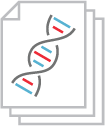The European Hematology Association (EHA) Congress 2025 brought together global leaders in hematologic research, diagnostics, and therapeutics, and Mission Bio was proud to be a key contributor to the conversation. From cutting-edge talks to impactful poster sessions, the role of single-cell and multi-omic analysis in advancing our understanding of blood cancers was central, and Tapestri-powered insights were featured in 4 oral and 6 poster presentations.
New Capability Announcement: Targeted DNA + Gene Expression on a Single Cell Platform
At EHA 2025, Mission Bio also announced a major expansion to the Tapestri platform—the ability to simultaneously profile targeted DNA and gene expression at the single-cell level. This new capability will empower researchers to connect genotype with transcriptional phenotype, unlocking a richer understanding of disease biology, clonal fitness, and therapeutic response.
This marks a new chapter in precision hematology, enabling integrated views of how genomic alterations translate into functional consequences—directly in patient samples.
Single-Cell Spotlight: Tapestri in Key EHA Presentations
This year, several leading investigators showcased how the Tapestri Platform is driving transformative insights across disease biology, treatment response, and therapeutic innovation:
Clonal Architecture and Early Mutation Events in AML
Studies led by Dr. Wencke Walter and Dr. Masanori Motomura explored how somatic mutations like NPM1, DNMT3A, and TET2 arise in early progenitor cells and shape disease heterogeneity. Tapestri’s ability to simultaneously genotype and profile chromatin accessibility at the single-cell level revealed co-mutation patterns and epigenetic landscapes that bulk sequencing fails to resolve.
These findings highlight the early evolution of AML and the importance of tracking not just mutations but their epigenetic context, especially in preleukemic conditions and clonal hematopoiesis.
MRD and Treatment Response Across Disease Stages
Tapestri enabled deeper profiling of minimal residual disease (MRD) in two distinct clinical contexts:
- In AML treated with Venetoclax + Azacitidine, Prof. Jiří Mayer identified three unique MRD kinetic patterns associated with relapse risk and therapeutic efficacy.
- In the SAL BLAST trial, Dr. Enise Ceran used single-cell MRD profiling to demonstrate that CXCR4 expression in AML blasts predicts resistance to CXCR4 inhibitors and correlates with relapse.
Both studies demonstrate how single-cell MRD assessment provides more actionable insight than standard bulk methods, especially when timing and clonal shifts matter most.
Precision Medicine in Myeloproliferative Neoplasms
Posters by Dr. Sebastiano Rontauroli and Dr. Lara Tavernari advanced our understanding of myelofibrosis, using Tapestri to track clonal dynamics and treatment effects at a granular level. Their findings revealed:
- How Ruxolitinib alters the clonal makeup and immune microenvironment in responders vs. non-responders.
- The discovery of CD9 as a marker for disease-propagating stem cells with increased engraftment potential—positioning it as a novel therapeutic target in MF.
Clinical Impact of Targeted and Synthetic Approaches
Several oral presentations expanded the view of where single-cell technologies intersect with translational and clinical innovation:
- Dr. Marina Konopleva presented data on Tagraxofusp, a CD123-targeted therapy in BPDCN, showing durable remissions and restoration of normal hematopoiesis without cumulative toxicity—opening the door for CD123-targeted combinations.
- Dr. Linde Miles shared insights into clonal evolution of NPM1-mutant AML through genetic and genomic approaches.
- In a visionary keynote, Dr. Lars Velten highlighted the convergence of synthetic genomics and single-cell profiling to map blood formation and cellular plasticity, showcasing the power of precision engineering in hematology.
- And in a late-breaking abstract presentation, Dr. John Mascarenhas presented INCA33989, a mutant CALR-specific antibody that delivered molecular responses and platelet normalization in high-risk patients—demonstrating first-in-class therapeutic potential.
The Power of One: A Night of Multiomics Discovery
Our EHA 2025 speaker dinner, “The Power of One: A Night of Multiomics Discovery,” was more than an event—it was a celebration of community, collaboration, and scientific progress. This evening brought together peers from across academia, biotech, and pharma for meaningful conversation, shared insights, and bold ideas.
The night featured two impactful scientific presentations:
- “Single Cell Multiomic Analysis of KMT2A-rearranged Pediatric Acute Leukemia Clonal Evolution” – Dr. Linde Miles
- “Tracing Blood Stem Cell Clones with Somatic Epimutations” – Dr. Lars Velten
Paired with engaging dialogue and a shared passion for advancing hematologic research, the evening underscored the power of connection—and the growing impact of integrated single-cell multi-omics in shaping the future of precision medicine.
Explore the Data
To help you revisit and explore the insights from EHA 2025, we’ve created a dedicated resource page featuring summaries of each presentation and poster, along with additional tools and data:
View the EHA 2025 Resource Page
The Future of Hematology Is Single-Cell
EHA 2025 made one thing clear: single-cell and multi-omic analysis are no longer optional—they’re essential. Whether it’s decoding clonal evolution, tracking MRD with unmatched sensitivity, or validating novel therapeutic targets, Mission Bio remains committed to equipping researchers and clinicians with the tools to transform care.
Let’s keep the conversation going. If you’re interested in learning more or collaborating, contact us or schedule a time to talk.










